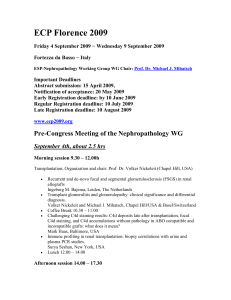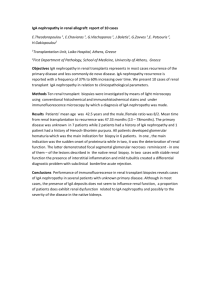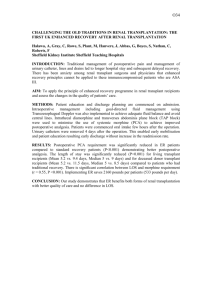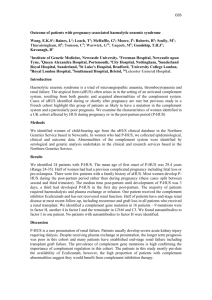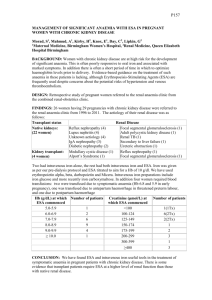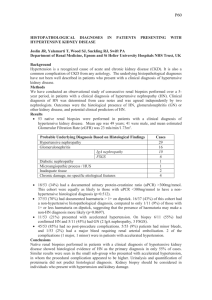recurrence of cfhr5 nephropathy in a renal transplant
advertisement
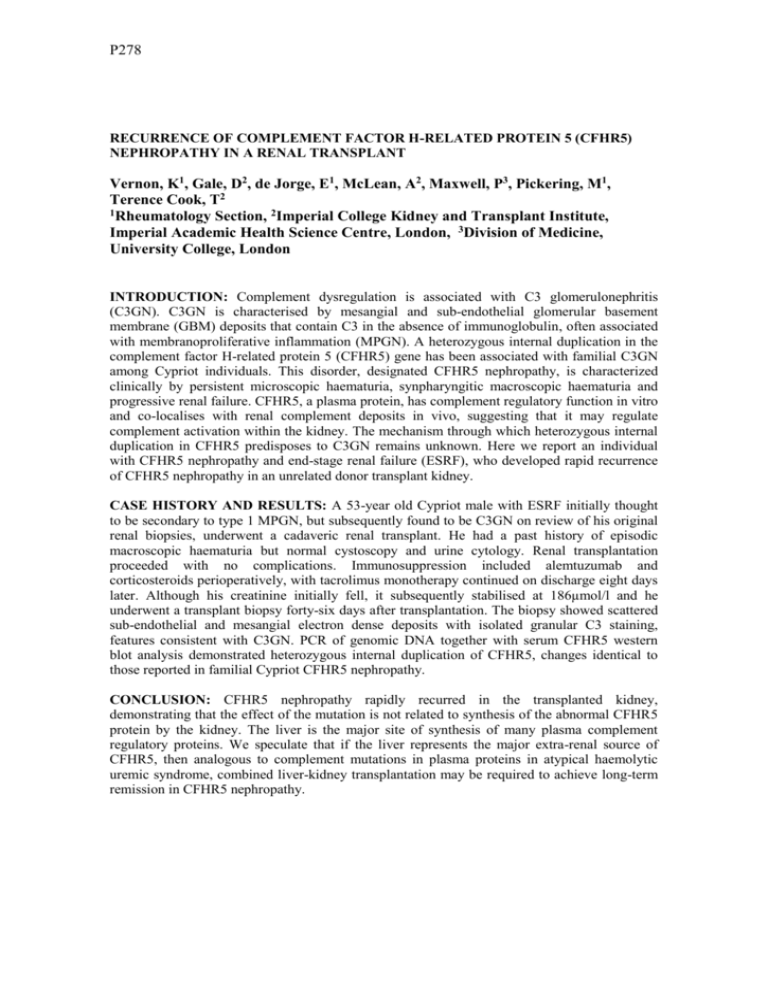
P278 RECURRENCE OF COMPLEMENT FACTOR H-RELATED PROTEIN 5 (CFHR5) NEPHROPATHY IN A RENAL TRANSPLANT Vernon, K1, Gale, D2, de Jorge, E1, McLean, A2, Maxwell, P3, Pickering, M1, Terence Cook, T2 1Rheumatology Section, 2Imperial College Kidney and Transplant Institute, Imperial Academic Health Science Centre, London, 3Division of Medicine, University College, London INTRODUCTION: Complement dysregulation is associated with C3 glomerulonephritis (C3GN). C3GN is characterised by mesangial and sub-endothelial glomerular basement membrane (GBM) deposits that contain C3 in the absence of immunoglobulin, often associated with membranoproliferative inflammation (MPGN). A heterozygous internal duplication in the complement factor H-related protein 5 (CFHR5) gene has been associated with familial C3GN among Cypriot individuals. This disorder, designated CFHR5 nephropathy, is characterized clinically by persistent microscopic haematuria, synpharyngitic macroscopic haematuria and progressive renal failure. CFHR5, a plasma protein, has complement regulatory function in vitro and co-localises with renal complement deposits in vivo, suggesting that it may regulate complement activation within the kidney. The mechanism through which heterozygous internal duplication in CFHR5 predisposes to C3GN remains unknown. Here we report an individual with CFHR5 nephropathy and end-stage renal failure (ESRF), who developed rapid recurrence of CFHR5 nephropathy in an unrelated donor transplant kidney. CASE HISTORY AND RESULTS: A 53-year old Cypriot male with ESRF initially thought to be secondary to type 1 MPGN, but subsequently found to be C3GN on review of his original renal biopsies, underwent a cadaveric renal transplant. He had a past history of episodic macroscopic haematuria but normal cystoscopy and urine cytology. Renal transplantation proceeded with no complications. Immunosuppression included alemtuzumab and corticosteroids perioperatively, with tacrolimus monotherapy continued on discharge eight days later. Although his creatinine initially fell, it subsequently stabilised at 186µmol/l and he underwent a transplant biopsy forty-six days after transplantation. The biopsy showed scattered sub-endothelial and mesangial electron dense deposits with isolated granular C3 staining, features consistent with C3GN. PCR of genomic DNA together with serum CFHR5 western blot analysis demonstrated heterozygous internal duplication of CFHR5, changes identical to those reported in familial Cypriot CFHR5 nephropathy. CONCLUSION: CFHR5 nephropathy rapidly recurred in the transplanted kidney, demonstrating that the effect of the mutation is not related to synthesis of the abnormal CFHR5 protein by the kidney. The liver is the major site of synthesis of many plasma complement regulatory proteins. We speculate that if the liver represents the major extra-renal source of CFHR5, then analogous to complement mutations in plasma proteins in atypical haemolytic uremic syndrome, combined liver-kidney transplantation may be required to achieve long-term remission in CFHR5 nephropathy.
